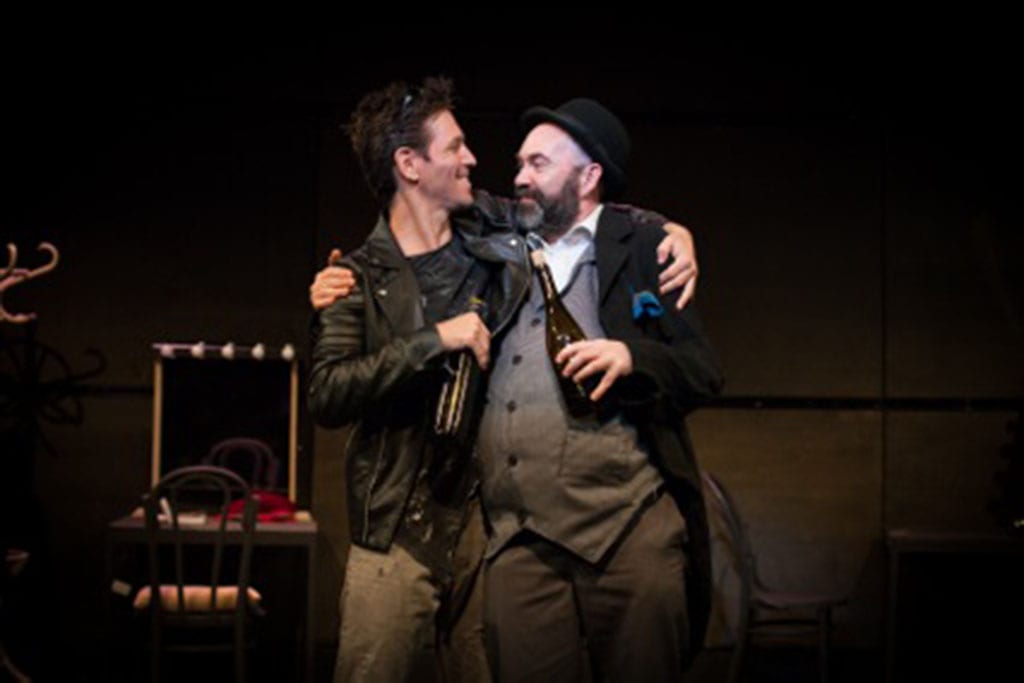This notable contribution to this year’s RADA Festival extracts the central relationships and confrontations from Henry IV, Parts 1 & 2 and places them within a framing device of an older and younger actor engaged in a tense relationship where authority is placed under continual question and scrutiny. Dori Engel plays Prince Hal and Hotspur, the two insurgent youngsters, and Jeff Lewis depicts Henry IV and Falstaff, the two patriarchal figures with whom they joust.
The original plays contain such teeming multitudes of characters and themes that it is refreshing to have these few themes and characters viewed in isolation. How is respect for authority earned? How is the balance between charisma and self-discipline to be struck in a ruler? How do youth and age manage and reconcile their differences? How is personal honour and identity to be defined in public and private? These are timeless dramatic questions that are given new focus here by hearing these famous episodes of rule and misrule stitched together as one whole. It is also helpful and moving to have the description of the death of Falstaff from Henry V brought into play as a natural conclusion.
We begin and end with dressing-room tensions as bracketing devices. While it is clear that some kind of framework for the sections of Shakespeare is needed, it could be knitted closer into the fabric of the play at other points. The play really comes fully alive in the famous role reversal scene in which Hal and Falstaff both pretend to pass judgement on the other in the guise of Henry IV. Up to that point the pace had been a little slow, as if the actors were playing Beckett rather than Shakespeare (there were hints of Godot in the costumes too); but after that catalytic moment there was a compelling momentum that took us through to the end.
Engel’s performance as Hal and Hotspur was a bravura one, especially in the battle scenes, where he has to somehow project both characters at the same time and generate a plausible movement sequence for the conflict. This he did with great success. He also provides a pleasing contrast between the happy-go-lucky Hal and the cold figure of authority that rejects Falstaff: we saw in his acting how the seeds of the second were already present in the first.
Lewis gives equal weight to his characterization of Henry IV as to Falstaff. Hearing Henry’s speeches in close proximity reminded one of the texture of the muscular, pragmatic verse and imagery that Claudius has in Hamlet: they are cut from the same political cloth. He also captured the wily and evasive side to Falstaff as much as the more crowd-pleasing genial jocularity. He also deserves praise for switching from fat-suit to burgundy royal robe with such speed!
One particular delight of this production is the work of composer/musician Daniel Sapir, who is onstage throughout with an array of instruments specially designed for the production, often from the simplest found objects and domestic gadgets. His inventiveness compensated for the fact that there are not more players by providing sounds that represent the characters and provide interludes in the action while the actors prepare for the next scene. One instrument that stood out was a simple bed post with a bass string on one side and two violin strings on the other, the one representing the king and Falstaff and the other Hal and Hotspur.
This play offers fine opportunities for two actors to display a full gamut of technical skills and emotions. It also invites the audience to think afresh about plays we think know very well, but which in fact reveal fresh treasures when evoked and cherished by performers of real talent and imagination.

